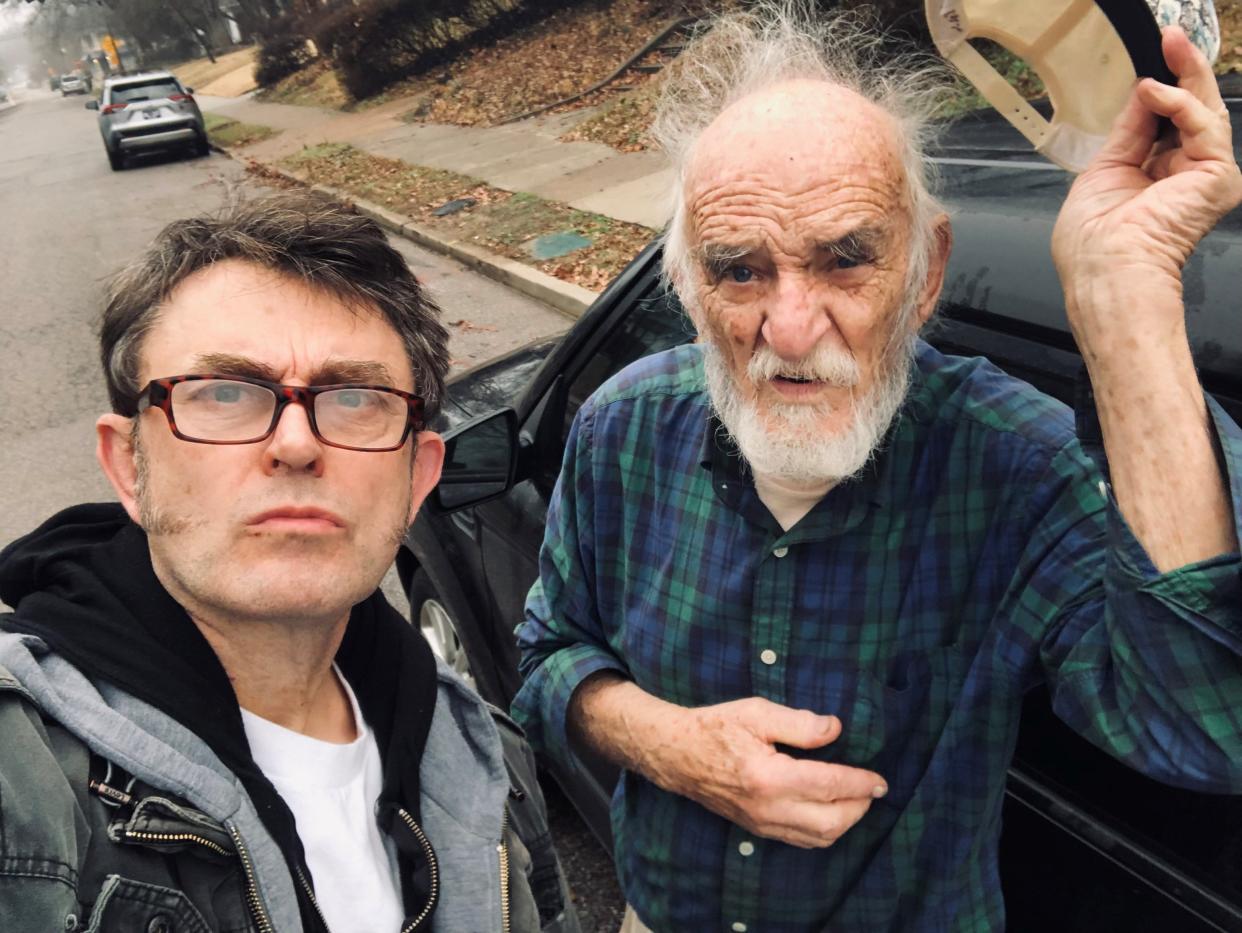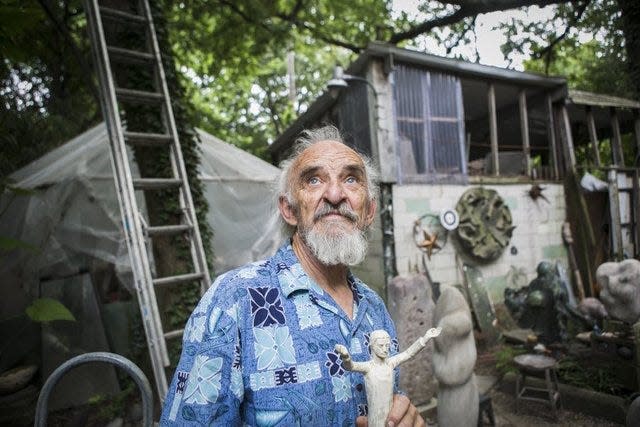'Beatnik Manor': The story behind this 1970s Memphis 'time capsule' / new documentary

Saturday, filmmaker Mike McCarthy will present his latest work, "Beatnik Manor," at the Malco Studio on the Square.
The movie is a documentary, culled from footage captured in the early 1970s by puckish bohemian artist John McIntire and his students at the now-closed Memphis College of Art in Overton Park.
McCarthy, a pioneer of Memphis do-it-yourself filmmaking whose previous projects include such titles as "Damselvis, Daughter of Helvis" and "Teenage Tupelo," is a master of ballyhoo and self-promotion. McIntire is not. (Or is it that he pretends he is not?)
Reached by phone at the Midtown home he shares with three cats named Ding Ding, Big Boy and Twitter, the self-deprecating McIntire expressed skepticism about the project.
"Those are old movies I should have thrown away," said McIntire, 88. "They're so raggedy, those old nitrate films."
Entertainment news:Katori Hall talks 'P-Valley', Tina Turner musical and impacting culture
Memphis history:Pinocchio's, Poplar Tunes and more: 10 Memphis businesses we miss
He said if he attends the film premiere, "I'll go incognito. I'll put on a disguise or something."
McCarthy, meanwhile, says disguises are acceptable. He just wants people to show up.
The story behind 'Beatnik Manor'
Running close to 50 minutes, "Beatnik Manor" is "A Memphis Art School Super 8 Time Machine," according to the event's promotional poster.
McCarthy, 60, describes the documentary as "hallucinogenic." It's experimental form represents a sympathetic response to the irreverent ethos of the artists, writers, musicians, students and other free thinkers who frequently gathered at the McIntire home at 2166 Madison, which McIntire says was dubbed "Beatnik Manor" by the poet Kenneth Lawrence Beaudoin (a pal of such luminaries as William Carlos William and e.e. cummings).
"The thing is sort of beautiful in the way it doesn't make sense," McCarthy said of the film. "You're not in for a traditional documentary narrative. This is more of a dreamscape involving a lot of bohemian, hippie-looking kids in Memphis, shooting footage with cameras provided by a teacher who probably didn't give them a lot of instruction and probably didn't even know how to use the camera too well himself."
McCarthy said McIntire was his sculpture instructor in the mid-'80s at the Memphis Academy of Art (as the school was then known). At the time, McCarthy wanted to be a cartoonist. "He was a student of mine for one semester, trying to be famous," McIntire said.
A few decades later, McIntire began showing up at McCarthy's Midtown home, with boxes of Super 8 footage. "I had hundreds and hundreds and hundreds of boxes in this house that would explode if somebody walked in with a cigarette," McIntire said. "It was all nitrate film."
For McCarthy — a devotee of what he calls "unpopular culture" and an unofficial historian of the old, weird Memphis — the boxes were a treasure trove, even if the footage was "raggedy": shaky, silent, random, sometimes out of focus, and decomposed by time.
Some of the footage was, essentially, documentary. Other images captured art school parties or "happenings" or events. In some cases, students had drawn or scratched images onto the film stock.
With backing from producer Dennis Black, McCarthy and editor Justin Elliott Thompson transferred the footage to digital, and edited it into what McCarthy calls "a piece of art." ("Calling me the 'director' of this is a very loose term," he said. "The artistic weight really belongs to Justin.") Rather than trying to erase the ravages of time, the filmmakers embraced the imperfection, layering pieces of footage on top of each other to amplify the visual noise.
Meanwhile, McCarthy taped interviews with McIntire, in person and — during the COVID-19 shutdowns — via cellphone. The veteran Memphis artist — whose work can be found outside City Hall and at Graceland — discussed his life, his schooling, his move from Pittsburgh to Memphis at the behest of art college head Ted Rust, and other topics, such as his reputation as a "warlock" and his stint as the founder and operator of the Bitter Lemon, an influential coffeehouse/folk-music club in the 1960s.
At one point, McIntire discusses his history of astral projection, which began when he was a teenager.
"I was 18, and I left my body, and it scared me," he says. "I thought I died, and I floated out of the room down the hallway of our house, and I was going out through a wall... It was more than a dream, it's for real."
Memphis concerts:The Beatles, Elvis, Jay-Z and more: 15 Mid-South Coliseum concerts to remember
Movies, music and more:From 'Gray Man' to Rube Goldberg: 7 things to do in Memphis
'A tribute to Overton Park'
While the title "Beatnik Manor" specifically alludes to McIntire's house, it might also refer to the art college and to Overton Park in general during the 1960s and '70s.
"This is a tribute to Overton Park," McCarthy said. "When I moved here in 1984 from smalltown Mississippi, I had never been to a museum before. I had never been to a real art school before. So, Overton Park was kind of my gateway drug to Memphis culture. Now, we've lost the school and soon the Brooks Museum." (The College of Art closed in 2020; the Memphis Brooks Museum remains open in Overton Park, but plans to relocate to a new $100 million Downtown location by 2026.)
He said the Memphis arts scene of that era had a percolating national reputation, thanks to people like McIntire, photographer William Eggleston, musician Alex Chilton and others whose antics and creations are chronicled in such sources as Robert Gordon's book, "It Came from Memphis," and the Eggleston film, "Stranded in Canton."

In the footage that makes up "Beatnik Manor," such people and their fellow travelers "are on the fringes of the frame, like how they're on the fringes of society, in the Memphis underground," McCarthy said.
Said McIntire: "I'm one of the few left alive from that period."
More than 'Manor'
"Beatnik Manor" screens at 3 and 5 p.m. Saturday at the Studio on the Square, at Overton Square.
The location is close to the location of McIntire's original home (a site now occupied by the Ballet Memphis building). The date, too, is significant.
Saturday marks the 25th anniversary of David Bowie's two sold-out "Ziggy Stardust" concerts at Downtown's Ellis Auditorium. Bowie is a McCarthy hero, but, more to the point, the rock star visited the Memphis Academy of Art during his stop here, at the invitation of instructor Dolph Smith, a painter.
That's why a Bowie "pop-up" shop will be in the movie theater lobby Saturday. In addition, four short films will accompany the 48-minute "Beatnik Manor" documentary. While "Beatnik Manor" revisits the past, the shorts will "point to the future," McCarthy said.
Tickets are $10, and are available in advance at malco.com.
This article originally appeared on Memphis Commercial Appeal: 'Beatnik Manor': What to know about Mike McCarthy's new documentary

